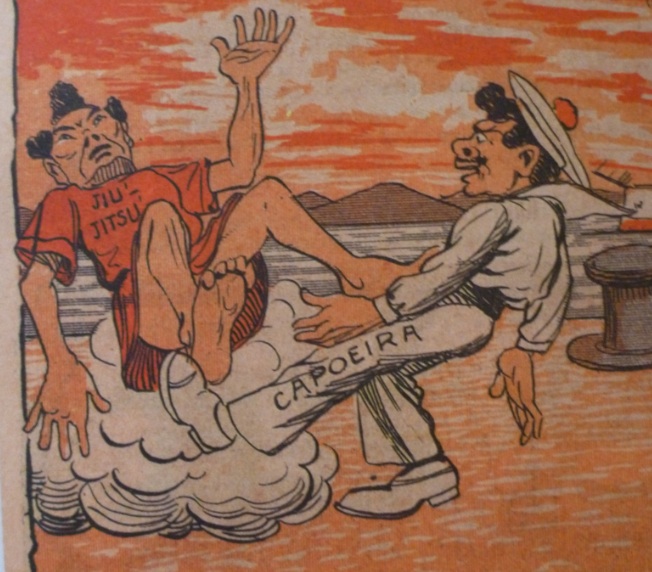
Rasteira was certainly one of the primary fighting techniques of Capoeira Carioca. Rasteira also played an important role in Bahian Capoeira (Angola and the original Regional).
However, to interpret this correctly, we have to know what exactly 'rasteira' meant in different ages and contexts.
In Capoeira Carioca of 19th century, 'rasteira' meant standing rasteira. Not only that, it meant standing rasteira done using Snake and Crane mechanics: Snake pull, then Crane throw.
Proper rasteira only takes the front leg; but its mechanics makes it pull both of opponent's legs from under him.

Additionally, there was a low version of rasteira; done using the same mechanics: Snake pull, then Crane throw. It is easily distinguishable by the final position, where both hands are behind the fighter.

To broaden readers understanding, let us also list similar low sweeping techniques that sometimes get confused with Rasteira.
1)The first one is Corta Capim. Corta capim is a low takedown done by circling the leg around the fighter, using Snake archetype, then jumping over the leg using Seduction1 to throw the opponent down. Again, it only takes front leg. It differs from low rasteira in the angle of attack; Rasteira goes from the front, while Corta capim goes from the side and pulls with the heel.
2)The second one is Calço. Calço is another low takedown; however, it is done using LightLegs+Leopard+Seduction1 mechanics; taking both opponent's legs; the sweeping leg is inserted up to the knee.
Note that there is some confusion; people call Calço 'corta capim'; and rasteira 'calço'; but this is caused by people not being able to identify animal archetypes; these technique are distinct.
Now, let us go to Bahia.
In old Bahian capoeira, 'rasteira' seem to have meant low rasteira. In Bahia, the low rasteira differs from Carioca low rasteira in that the fighter turns in the direction of the sweep, with hands in front of him. I call this version 'Rasteira baiana'; it is done using Snake for pull, then Seduction1 for throw (the leg is lifted to the side).
This rasteira was used by both Angoleiros and Mestre Bimba in his original Regional. Like the Rio version, it can be used both against kicking or standing opponent; where it sweeps the front leg but takes both legs.
Old Bahian capoeira lacked a standing-up rasteira, for the simple reason that the above rasteira, Rasteira baiana, cannot be applied standing; the Seduction1 throwing does not allow it. This is why they call 'rasteira' their low rasteira.
I repeat: There was no standing rasteira in old Bahian capoeira; Bimba, in his original Regional, taught Banda tracada, but that is a banda and thus something a bit different.
Finally, let us look at current situation.
As today's capoeira is continuation of the Bahian tradition, people still call 'rasteira' the Bahian low rasteira. However, they seem unaware of the fact this rasteira had a throwing part, done using Seduction1 mechanics; modern people do Bahian low rasteira only using Snake. Thus modern 'rasteira' is essentially crippled, and, unless the opponent is severelly off ballance, does not work.
I repeat: Modern 'rasteira' is trash; it is a crippled version of low Bahian rasteira that lacks the throwing part. In the rare instances people try to throw using this 'rasteira', it only shows how mechanically inefficient it is.
However, as people removed the Seduction1 part, this 'rasteira' can be now also done standing; so modern capoeira invented a standing up version of the above crippled rasteira; sometimes calling it 'banda de frente' or 'rasteira em pe'. This technique is similarly crippled; it only has the Snake pulling part and lacks the throwing part.
But modern people sometimes still want to throw the opponent down; and they recognized modern 'rasteiras' cannot be used for this. So they have another 'rasteira' that is not officially taught, but they use it when they want to take somebody down (ironic, isn't it?).
It is the standing swipe done using Rooster mechanics (this is the frontal Raspa of batuque). It is easily distinguishable from all previous techniques in that the sweep curves upward and the body hunches over. They also call this 'rasteira'; in this case, it is totally innapropriate, as there was never a Rasteira done using Rooster mechanics.
So to put it laconically: Modern capoeira has two crippled 'rasteiras' that do not throw; and one that throws, but it isn't in fact a rasteira.
---
The real, combat applicable and most elegant rasteira is the one from old Carioca; done both standing and on the ground. (Just do not confuse it with other, also elegant and applicable, Carioca techniques).
The old Bahian low rasteira is also passable, if done properly; but cannot be done standing.
As for the modern 'rasteiras', these are just examples of how capoeira degenerated through the 20th century, especially its later part.
This Web Page was Built with PageBreeze Free HTML Editor